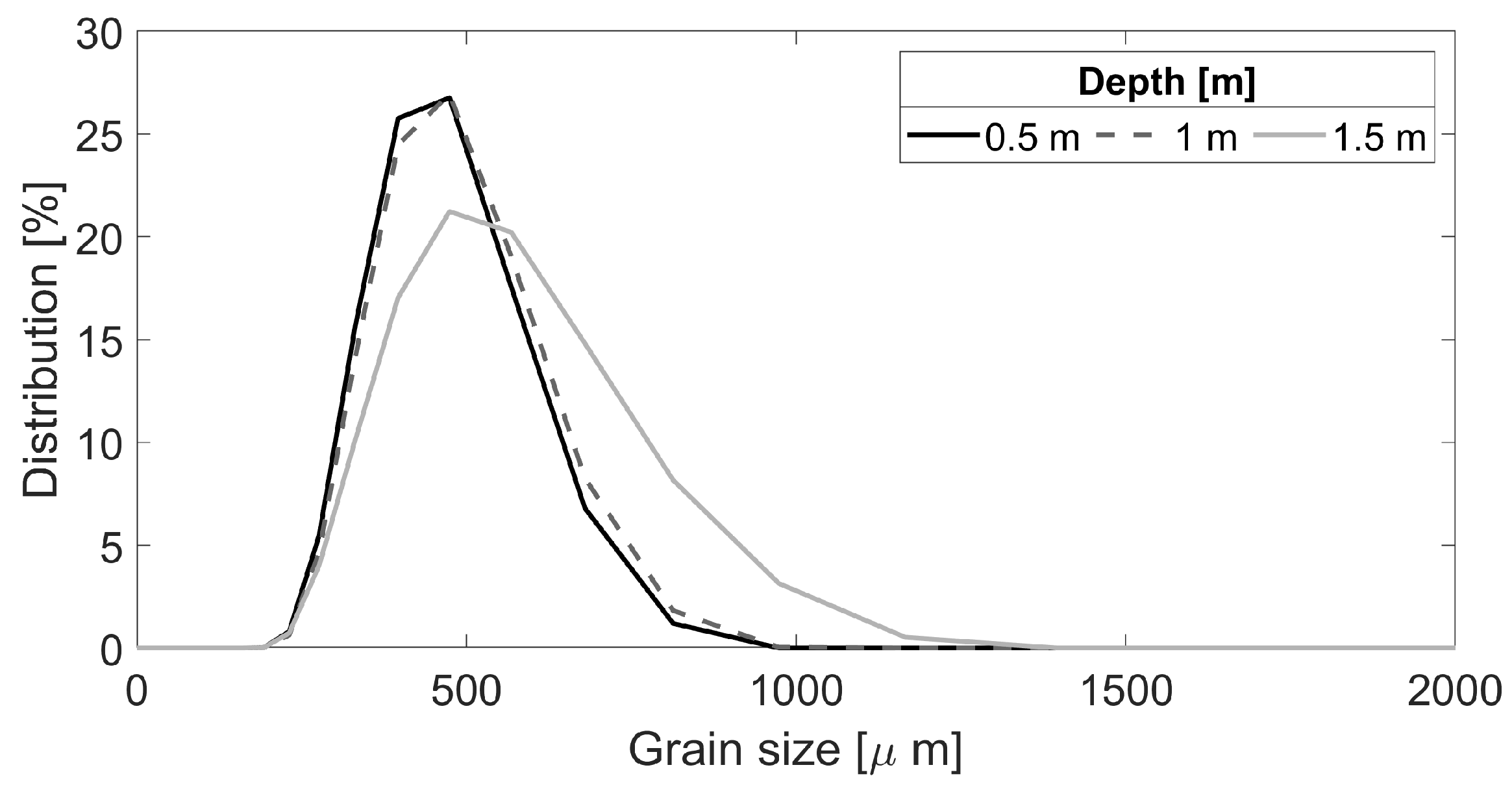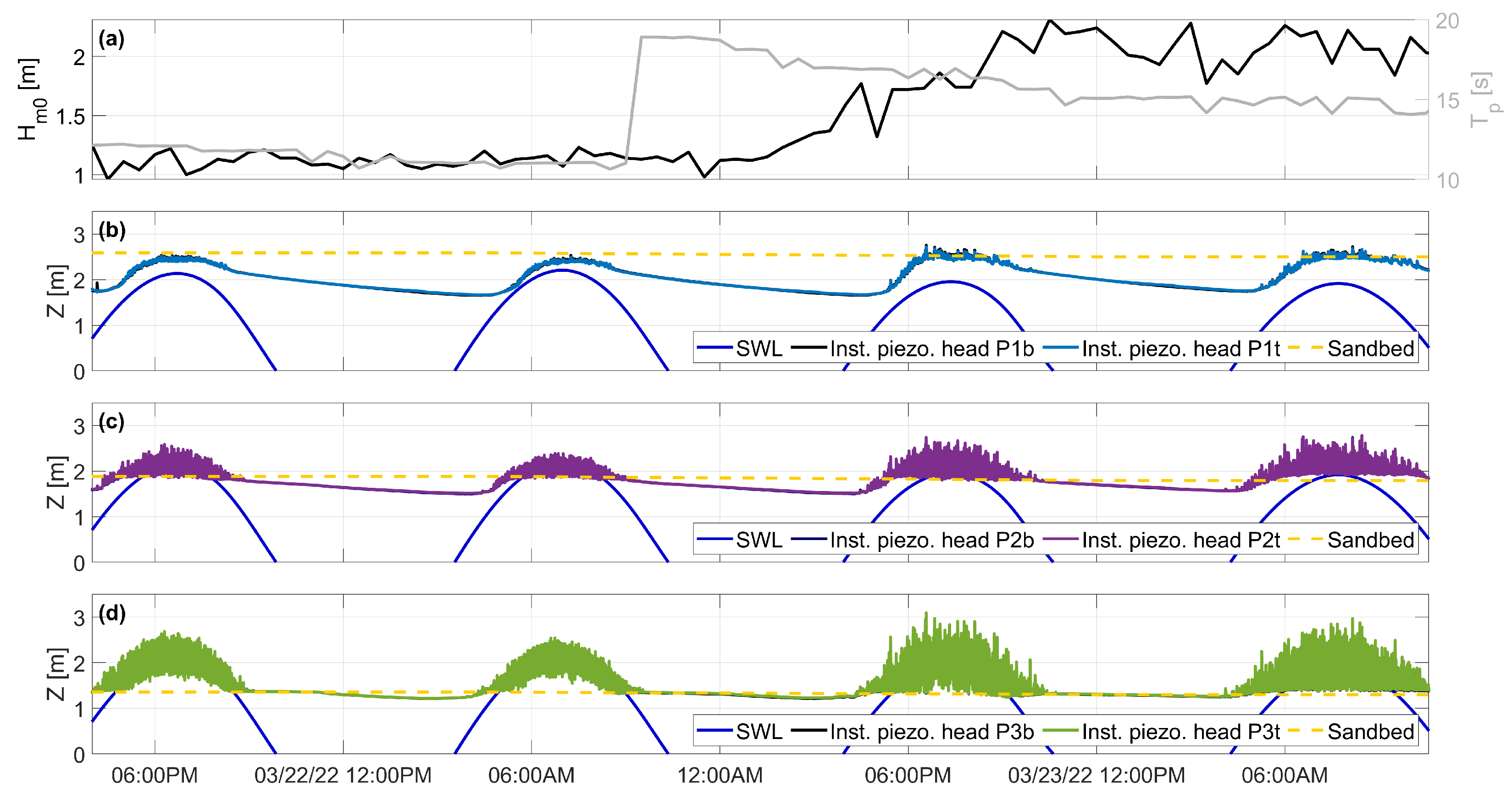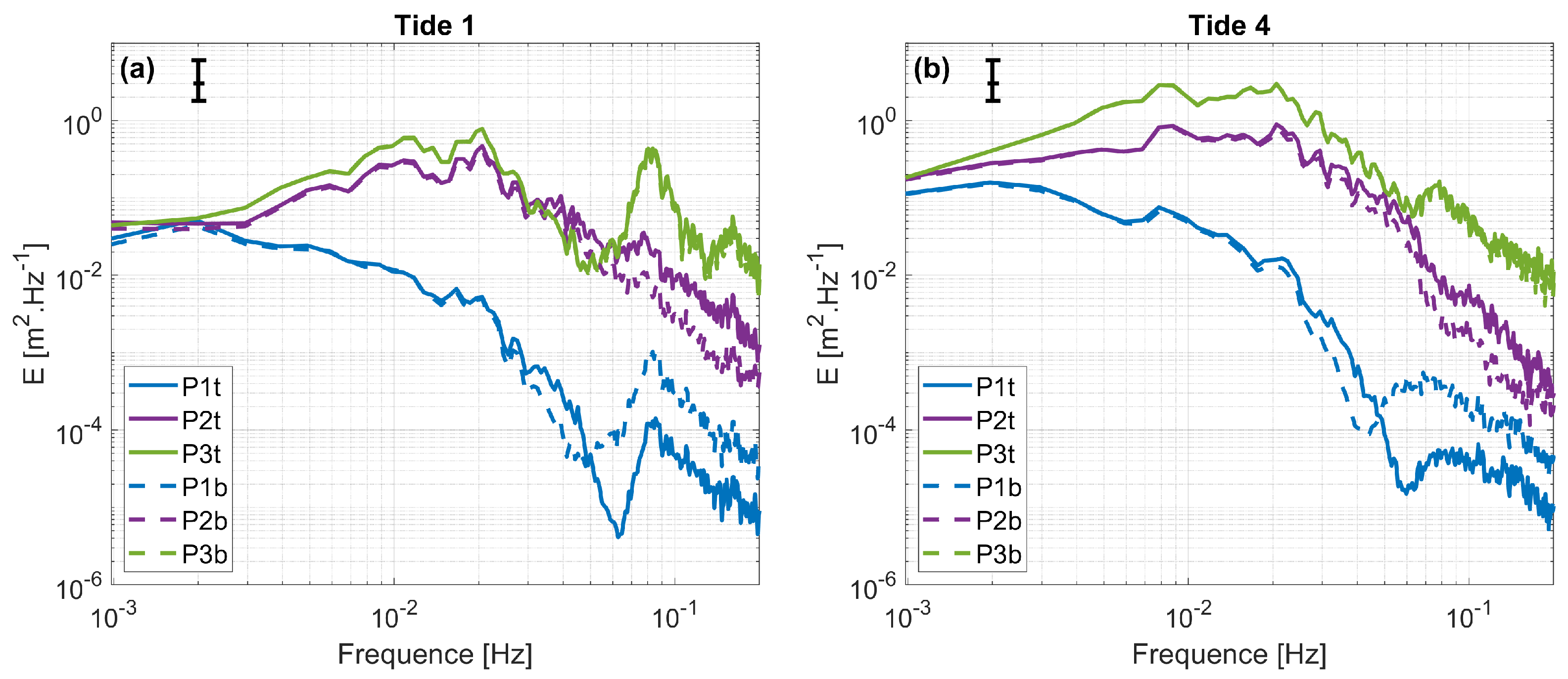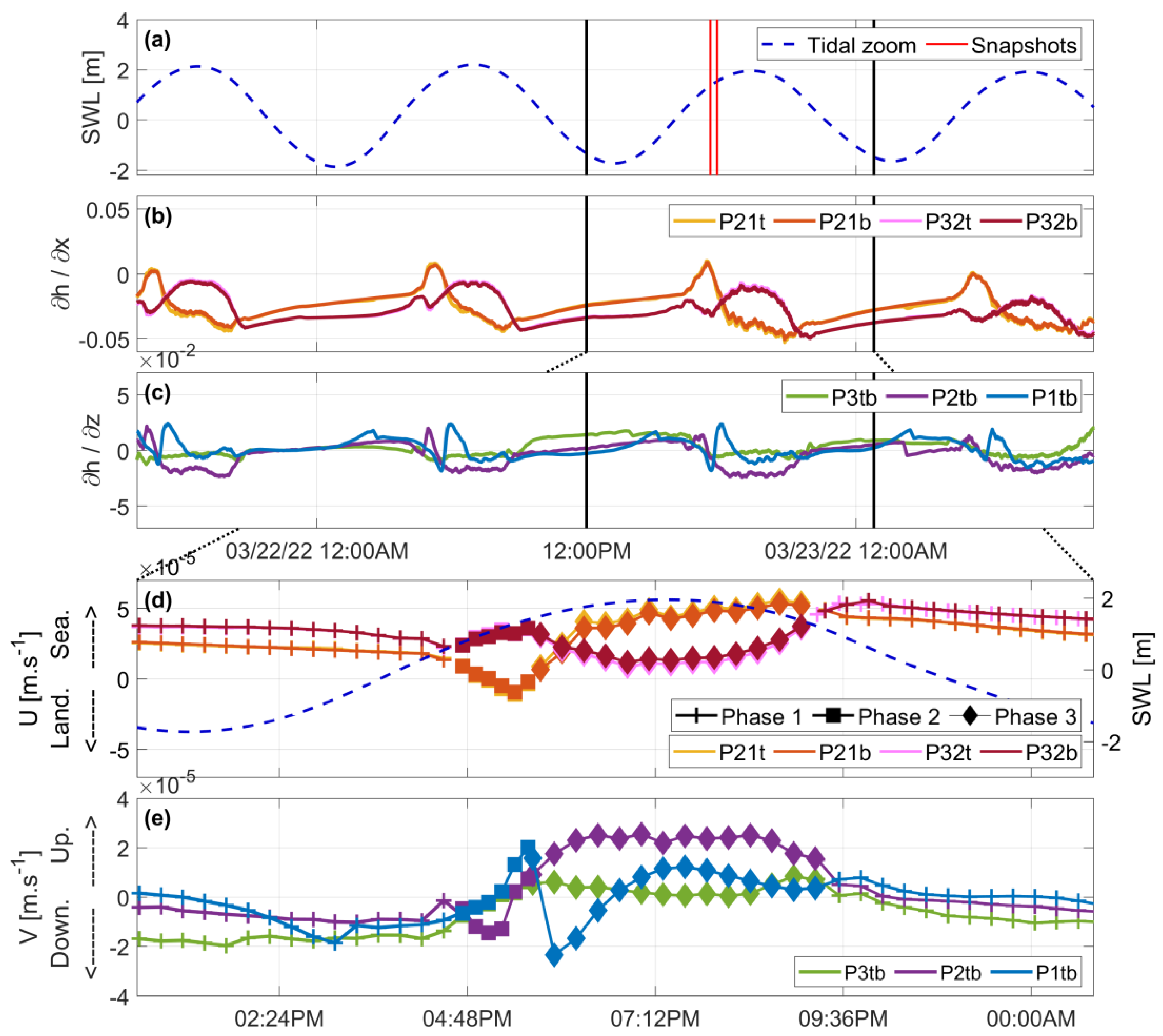Observations of Tide- and Wave-Driven Groundwater Dynamics in Meso-Tidal Sandy Beach
Abstract
:1. Introduction
2. Materials and Methods
2.1. Study Site
2.1.1. Site Description
2.1.2. Wave Climate
2.1.3. Coastal Aquifer
2.1.4. Granulometry
2.2. Instrumentation and Methods
3. Results
3.1. Measurements Overview
3.2. Tidal Dynamics
4. Discussion
5. Conclusions
Author Contributions
Funding
Data Availability Statement
Acknowledgments
Conflicts of Interest
References
- Nielsen, P. Tidal dynamics of the water table in beaches. Water Resour. Res. 1990, 26, 2127–2134. [Google Scholar] [CrossRef]
- Li, L.; Barry, D. Wave-induced beach groundwater flow. Adv. Water Resour. 2000, 23, 325–337. [Google Scholar] [CrossRef]
- Burnett, W.; Aggarwal, P.; Aureli, A.; Bokuniewicz, H.; Cable, J.; Charette, M.; Kontar, E.; Krupa, S.; Kulkarni, K.; Loveless, A.; et al. Quantifying submarine groundwater discharge in the coastal zone via multiple methods. Sci. Total Environ. 2006, 367, 498–543. [Google Scholar] [CrossRef] [PubMed]
- Robinson, C.; Gibbes, B.; Li, L. Driving mechanisms for groundwater flow and salt transport in a subterranean estuary. Geophys. Res. Lett. 2006, 33, 2005GL025247. [Google Scholar] [CrossRef]
- Charbonnier, C.; Anschutz, P.; Poirier, D.; Bujan, S.; Lecroart, P. Aerobic respiration in a high-energy sandy beach. Mar. Chem. 2013, 155, 10–21. [Google Scholar] [CrossRef]
- Sous, D.; Lambert, A.; Rey, V.; Michallet, H. Swash–groundwater dynamics in a sandy beach laboratory experiment. Coast. Eng. 2013, 80, 122–136. [Google Scholar] [CrossRef]
- Heiss, J.W.; Puleo, J.A.; Ullman, W.J.; Michael, H.A. Coupled surface-subsurface hydrologic measurements reveal infiltration, recharge, and discharge dynamics across the swash zone of a sandy beach. Water Resour. Res. 2015, 51, 8834–8853. [Google Scholar] [CrossRef]
- Sous, D.; Petitjean, L.; Bouchette, F.; Rey, V.; Meulé, S.; Sabatier, F.; Martins, K. Field evidence of swash groundwater circulation in the microtidal rousty beach, France. Adv. Water Resour. 2016, 97, 144–155. [Google Scholar] [CrossRef]
- Turner, I.L.; Rau, G.C.; Austin, M.J.; Andersen, M.S. Groundwater fluxes and flow paths within coastal barriers: Observations from a large-scale laboratory experiment (BARDEX II). Coast. Eng. 2016, 113, 104–116. [Google Scholar] [CrossRef]
- Geng, X.; Heiss, J.W.; Michael, H.A.; Boufadel, M.C. Subsurface Flow and Moisture Dynamics in Response to Swash Motions: Effects of Beach Hydraulic Conductivity and Capillarity. Water Resour. Res. 2017, 53, 10317–10335. [Google Scholar] [CrossRef]
- Perera, E.; Zhu, F.; Dodd, N.; Briganti, R.; Blenkinsopp, C.; Turner, I.L. Surface-groundwater flow numerical model for barrier beach with exfiltration incorporated bottom boundary layer model. Coast. Eng. 2019, 146, 47–64. [Google Scholar] [CrossRef]
- Moore, W.S. The Effect of Submarine Groundwater Discharge on the Ocean. Annu. Rev. Mar. Sci. 2010, 2, 59–88. [Google Scholar] [CrossRef] [PubMed]
- Horn, D.P. Beach groundwater dynamics. Geomorphology 2002, 48, 121–146. [Google Scholar] [CrossRef]
- Grant, U. Effects of groundwater table on beach erosion. Bull. Geol. Soc. Am. 1946, 57, 1252, (Abstract). [Google Scholar]
- Contestabile, P.; Aristodemo, F.; Vicinanza, D.; Ciavola, P. Laboratory study on a beach drainage system. Coast. Eng. 2012, 66, 50–64. [Google Scholar] [CrossRef]
- Fischione, P.; Pasquali, D.; Celli, D.; Di Nucci, C.; Di Risio, M. Beach Drainage System: A Comprehensive Review of a Controversial Soft-Engineering Method. J. Mar. Sci. Eng. 2022, 10, 145. [Google Scholar] [CrossRef]
- West, N. Beach Use and Behaviors. In Encyclopedia of Coastal Science; Finkl, C.W., Makowski, C., Eds.; Series Title: Encyclopedia of Earth Sciences Series; Springer International Publishing: Cham, Switzerland, 2019; pp. 307–311. [Google Scholar] [CrossRef]
- Lafon, V.; Froidefond, J.M.; Lahet, F.; Castaing, P. SPOT shallow water bathymetry of a moderately turbid tidal inlet based on field measurements. Remote Sens. Environ. 2002, 81, 136–148. [Google Scholar] [CrossRef]
- Lerma, A.N.; Billy, J.; Bulteau, T.; Mallet, C. Multi-Decadal Seawall-Induced Topo-Bathymetric Perturbations along a Highly Energetic Coast. J. Mar. Sci. Eng. 2022, 10, 503. [Google Scholar] [CrossRef]
- Castelle, B.; Bujan, S.; Ferreira, S.; Dodet, G. Foredune morphological changes and beach recovery from the extreme 2013/2014 winter at a high-energy sandy coast. Mar. Geol. 2017, 385, 41–55. [Google Scholar] [CrossRef]
- Anteagroup. Equipement et Suivi Géotechnique des Bâtiments de 1er Rang—Période 2020–2021; Anteagroup: White Plains, NY, USA, 2021. [Google Scholar]
- StatIC. Station Météorologique de Lacanau-Océan; InfoClimat. 2022. Available online: https://www.infoclimat.fr/observations-meteo/temps-reel/lacanau-ocean/000DZ.html (accessed on 1 July 2024).
- Turner, I.; Nielsen, P. Rapid water table fluctuations within the beach face: Implications for swash zone sediment mobility? Coast. Eng. 1997, 32, 45–59. [Google Scholar] [CrossRef]
- Krumbein, W.; Monk, G. Permeability as a Function of the Size Parameters of Unconsolidated Sand. Trans. AIME 1943, 151, 153–163. [Google Scholar] [CrossRef]
- Clément, J.B.; Sous, D.; Bouchette, F.; Golay, F.; Ersoy, M. A Richards’ equation-based model for wave-resolving simulation of variably-saturated beach groundwater flow dynamics. J. Hydrol. 2023, 619, 129344. [Google Scholar] [CrossRef]
- Turner, I.L.; Masselink, G. Swash infiltration-exfiltration and sediment transport. J. Geophys. Res. Ocean. 1998, 103, 30813–30824. [Google Scholar] [CrossRef]
- Labarthe, C. Relations Entre Granularité des Sédiments, Pente des PLAGES et Déferlement des Vagues. Ph.D. Thesis, Université de Bordeaux, Pessac, France, 2023. [Google Scholar]
- Geng, X.; Heiss, J.W.; Michael, H.A.; Boufadel, M.C.; Lee, K. Groundwater Flow and Moisture Dynamics in the Swash Zone: Effects of Heterogeneous Hydraulic Conductivity and Capillarity. Water Resour. Res. 2020, 56, e2020WR028401. [Google Scholar] [CrossRef]
- Geng, X.; Boufadel, M.C.; Jackson, N.L. Evidence of salt accumulation in beach intertidal zone due to evaporation. Sci. Rep. 2016, 6, 31486. [Google Scholar] [CrossRef] [PubMed]
- Lanyon, J.; Eliot, I.; Clarke, D. Observations of shelf waves and bay seiches from tidal and beach groundwater-level records. Mar. Geol. 1982, 49, 23–42. [Google Scholar] [CrossRef]
- Lewis, J.B. Measurements of groundwater seepage flux onto a coral reef: Spatial and temporal variations. Limnol. Oceanogr. 1987, 32, 1165–1169. [Google Scholar] [CrossRef]








Disclaimer/Publisher’s Note: The statements, opinions and data contained in all publications are solely those of the individual author(s) and contributor(s) and not of MDPI and/or the editor(s). MDPI and/or the editor(s) disclaim responsibility for any injury to people or property resulting from any ideas, methods, instructions or products referred to in the content. |
© 2024 by the authors. Licensee MDPI, Basel, Switzerland. This article is an open access article distributed under the terms and conditions of the Creative Commons Attribution (CC BY) license (https://creativecommons.org/licenses/by/4.0/).
Share and Cite
Woussen, E.; Sous, D.; Sénéchal, N. Observations of Tide- and Wave-Driven Groundwater Dynamics in Meso-Tidal Sandy Beach. Water 2024, 16, 1924. https://doi.org/10.3390/w16131924
Woussen E, Sous D, Sénéchal N. Observations of Tide- and Wave-Driven Groundwater Dynamics in Meso-Tidal Sandy Beach. Water. 2024; 16(13):1924. https://doi.org/10.3390/w16131924
Chicago/Turabian StyleWoussen, Emilie, Damien Sous, and Nadia Sénéchal. 2024. "Observations of Tide- and Wave-Driven Groundwater Dynamics in Meso-Tidal Sandy Beach" Water 16, no. 13: 1924. https://doi.org/10.3390/w16131924
APA StyleWoussen, E., Sous, D., & Sénéchal, N. (2024). Observations of Tide- and Wave-Driven Groundwater Dynamics in Meso-Tidal Sandy Beach. Water, 16(13), 1924. https://doi.org/10.3390/w16131924





